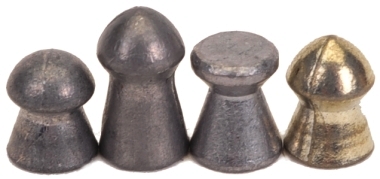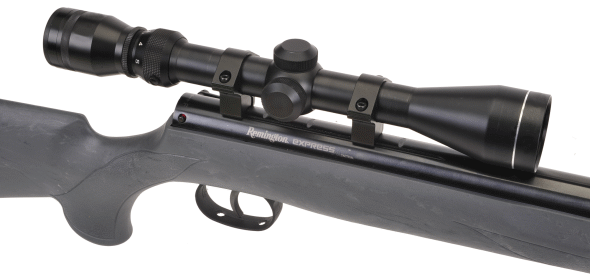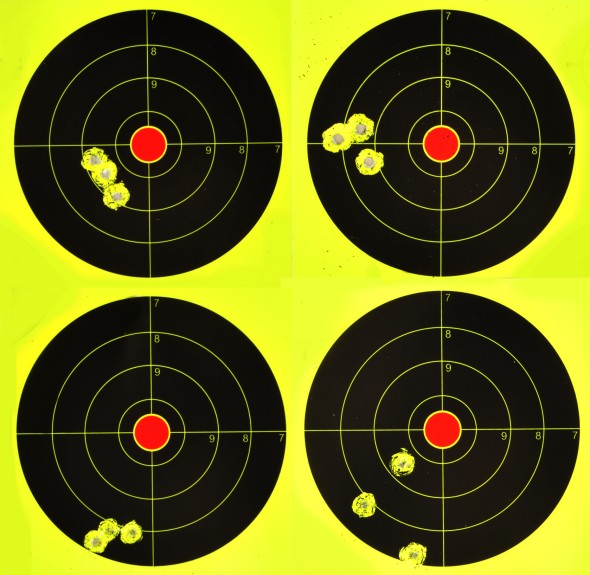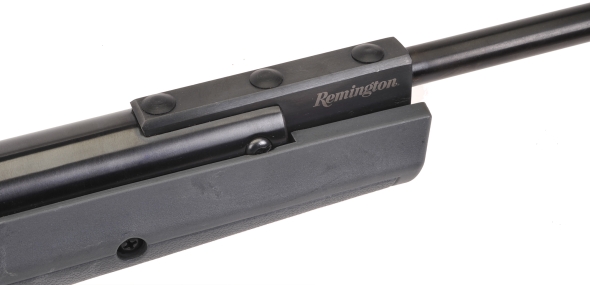
Remington’s Express™ XP Tactical is a .177 caliber, break barrel, single shot, spring-piston air rifle. It is rated for 1,300 fps with alloy pellets, capable of generating 23 ft-lbs of kinetic energy. Packaged with a 3x – 9x x 32mm scope and mounting hardware, all that is necessary to put the Express XP Tactical to work is enough arm strength to cock it and pellets to shoot. No external pressurized air supply or high pressure air pump apply.
|
Remington’s Express™ XP Tactical |
|
| Model | 89214 |
| Type | Break Barrel Spring – Piston |
| Caliber | .177″ |
| Barrel Length | 19.00“ |
| Rifling Twist | 1:16″ |
| Weight** | 7 Lbs 10 Oz |
| Overall Length* | 45 5/8″ |
| Stock | Synthetic |
| Hardware | Blue |
| Length of Pull* | 15 |
| Drop at comb* | 3/4″ |
| Drop at heel* | 3/4″ |
| Sights | Clean |
| Scope | 3/8″ Dovetail Integral |
| Trigger Pull* | 5 Lbs 9 Oz. |
| Safety | Cross Bolt Auto Reset |
| MSRP | $249.95 |
|
* Actual |
|
Air pressure, gun powder and other analogies…
Like other air rifles, the Remington Express uses compressed air in place of a firearm’s burning smokeless powder to produce propelling pressure. Smokeless powder burns, progressively building gas volume behind a moving bullet. The pressure in very high at the onset where the combined chamber and exposed bore volume are small and the bullet must overcome Newton’s First Law, lower as the bullet moves forward and exposes greater volume for the gases to fill. As long as the resistance of bore friction and atmospheric pressure on the nose of the bullet are less than the driving pressure, the bullet will accelerate. The greater the differential, the higher the rate of acceleration.
In a spring – piston air rifle, things are not so dissimilar. Pressure peaks when the spring piston is released within its cylinder with the pellet at rest in the gun’s bore. As the pellet moves forward, the spring powered piston continues forward, providing a constant, metered volume of pressurized gas until the piston movement has terminated or the pellet exits the gun’s barrel. As the volume of the bore behind the pellet increases, gas pressure decreases, as does the rate of acceleration of the pellet. The pellet will continue to accelerate, at a diminishing rate, as long as the pressure behind the pellet exerts greater force than the resistance of bore friction and atmospheric pressure.
Power and accuracy…
Break Barrel spring – piston rifles should not be confused with single pump or multi pump low power air rifles or spring powered BB Guns. In comparison to a number of expensive pre-charged high pressure air rifles that operate in the stored 2,000+ psi range, the Remington Express break barrel produced significantly higher velocity. As an indication of the type of compression that occurs in a spring – pistol rifle, when the sear is initially released, along with all of the spring’s stored energy, temperature of gases entering the gun’s bore can reach 2000ºF for a fraction of a second.
Ammunition
Pellets vary in: quality, weight, material, form, and application. In this case, only inexpensive, various types were selected. Why? A couple of reasons. The first is that inexpensive pellets are the biggest sellers. Pay less, shoot more, extremely precision shooting is rarely the objective. Second, air rifles require a significant amount of use before they are broken in, settle down and capable of doing their best, somewhere between 500 and 1000 shots is reasonable. So regardless ammo selected, we were not going to see the best this rifle had to offer.

| .177 Pellet Brand | Product | Listed Weight Grains |
Minimum Weight Grains* |
Maximum Weight Grains* |
% Δ |
Skirt Diameter Inches* |
Chrono FPS* |
| Crossman | Premier | 7.80 | 7.9 | 8.0 | 1.3 | 0.181 – 0.183 | 878 |
| GAMO | TS-10 Long Distance | 10.49 | 10.3 | 10.5 | 1.9 | 0.080 – 0.185 | 777 |
| Dynamit Nobel | Super Mag | 9.30 | 9.4 | 9.5 | 1.1 | 0.185 – 0.186 | 796 |
| GAMO | PBA Platinum | 4.70 | 4.1 | 5.2 | 26.8 | 0.182 – 0.183 | 1124 |
| * Average of 20 sampled | |||||||
Some of the characteristics of the ammo are indicated because, like a firearm, ammo has a direct bearing on the accuracy of an air rifle. In the case of the GAMO pellets, the weight swing within only 20 pellets is the equivalent of handloading 30-06 Springfield ammo with some rounds charged with 41 grains of powder and others with 56 grains. Velocity and point of impact would be all over the place.
In regard to things under the control of the Remington’s Express™ XP Tactical, pellets are sent on their way with very uniform nudge. Uniformity of spring – piston charge, based on chronographing scale weighed and match selected Crossman Premier pellets, was within 0.8%, or 7 fps; the percentage equivalent of quality handloaded or manufactured smokeless powder driven ammunition.
It takes more skill to shoot an air rifle accurately than a firearm…
Yes. Really. Most of my rifles end up with lightweight firing pins and heavier springs in an effort to shorten lock time; the dwell time between sear release and primer strike. I also handload so every rifle, with every bullet, has an MV of at least 4,000 fps so bullets get out of a gun’s barrel ASAP. Easy with the 220 Swift, not so much with the 450 Rigby… Yes, that is a tongue in cheek comment. The point is that I can only sit still for a couple of nanoseconds, so the time between squeezing a bullet and the bullet must exit a barrel must be short. That is not in the personality of an air rifle where the spring – piston dynamic is slow, as is a pellet’s voyage down a barrel.

Lock time for a Remington Model 700 is roughly 2.5 ms, which can be reduced to roughly 1.5 ms by reducing firing pin mass with light alloy replacement pieces. Dependent on pressure curves, bore friction and bullet density, a bullet exiting with a muzzle velocity of 3300 fps will pass through a rifle’s 24″ bore in approximately 1.0 ms. So for most of my rifles, 2.5 ms from sear release to bullet exit is all that it takes before I can resume normal breathing. An air rifle can have a combined lock and barrel time between 0.1 second and half an hour, dependent upon which high school physics class received the analysis assignment as a term project. In addition to the almost nap like period required to get the pellet out of the barrel, there is also two opposing recoil pulses to manage.
Subsequently, I followed a 100 yard range session with a 270 WSM that resulted in tiny 0.4″ groups with an air rifle that would yield only barn door size groups at 50 feet. The tone that may be present in my comments is one of embarrassment as I had to pause and reflect on good shooting techniques in order to get back on track. I could no longer slide by with bad habits that centerfire rifle short lock and barrel time accommodated. In the end analysis, the Remington Express XL Tactical was fine, it was impatient Joe’s shooting that was not doing the Remington justice. So I hunkered down, concentrated, watched my techniques and was able to shoot the following 3 shot, 50 foot groups –

Top Left, Crossman 0.6″. Top Right, GAMO TS-10 0.5″. Bottom Left, Super Mag, 0.6″, Bottom Right, GAMO PBA Platinum, 1.4″. My guess is that the GAMO Platinum weight variations contributed to the large group size. Due to tight time constraints imposed by weather, the rifle was not zeroed for each ammo type, as group size data was the primary interest. Shifts from bullseye are unadjusted shifts in point of impact.
Shooting personality
The Remington Express XL Tactical has the heft and size to approximate the feel of a centerfire rifle. The synthetic stock and recoil pad are on par with many good centerfire rifles on the market these days. Cocking the break barrel action requires more than a little effort, but it is manageable and it is necessary to achieve these power levels.

The included scope and mounting hardware are easy to install and appropriate in power and objective lens size for the application. For the most part, only the low end of the magnification range is necessary, but there is nothing stopping anyone from working on accuracy at longer distances. The sound suppressing device does make a difference when shooting heavier, low velocity pellets, even more so with high velocity alloy pellets.
There are five versions of the Remington Express, .22 and .177 caliber, all are supplied with scopes, some fixed 4x, some 3x-9x variables. There are models with wood stocks and some fitted with synthetic. Prices at discount retailers range from $129 to $189. There is essentially a model to suit most everyone with an interest in a good spring – pistol air rifle to use for target practice or for pest control and small game hunting. We’ll take a break at this point and come back with some further examination of how to extract more performance potential from the Remington Express. Fun. For additional information and specs, see the Express XT Tactical section on Remington’s site.

Email Notification